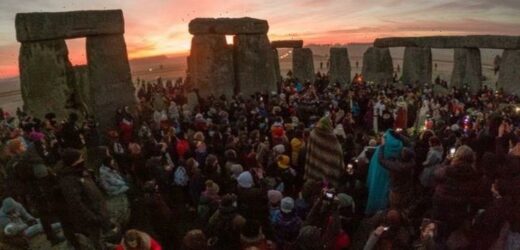Stonehenge: 'Mind-blowing' new discoveries discussed by experts
We use your sign-up to provide content in ways you’ve consented to and to improve our understanding of you. This may include adverts from us and 3rd parties based on our understanding. You can unsubscribe at any time. More info
The remarkable story of Stonehenge, one of the UK’s most iconic historical landmarks, will be told at a large exhibition at the British Museum, due to open in February. More than 250 objects are being loaned to the museum from institutions across six European nations and across the UK, in a bid to give context to the time in which it was built, some 4,500 years ago. The era marked a period of enormous social and technological change.
The Neolithic structure is the biggest of its kind anywhere on Earth, yet it is not entirely clear why it was built.
Its sheer size suggests it was vitally important to those who built it, but its true purpose has been the debate among archaeologists and historians for centuries.
A landmark study in 2019 suggested that the site could have been used for mass gatherings.
Archaeologists examined 131 pigs’ bones found at four Late Neolithic sites — Durrington Walls, Maden, Mount Pleasant and West Kennet Palisade Enclosures.


All of the sites served Stonehenge and Avebury, another Neolithic henge monument around 20 miles north of Stonehenge.
After extensive research, it was assumed that guests had brought meat raised locally to them, hence the pigs had arrived from all over the UK.
Isotope analysis of the bones showed animals raised in Scotland, the North East of England, West Wales, as well as numerous other parts of the British Isles.
No two pigs had the same isotope signature.

Study lead Dr Richard Madgwick told the BBC at the time: “This study demonstrates a scale of movement and level of social complexity not previously appreciated.
“These gatherings could be seen as the first united cultural events of our island, with people from all corners of Britain descending on the areas around Stonehenge to feast on food that had been specially reared and transported from their homes.”
The Neolithic henge complexes in the southwest are believed to have been the focal point for gatherings in the third millennium BC, with pigs the main animal used for food.
Dr Madgwick continued: “Arguably the most startling finding is the efforts that participants invested in contributing pigs that they themselves had raised.
DON’T MISS:
Mountain range disappeared into Yellowstone supervolcano magma chamber [INSIGHT]
Archaeology breakthrough as ‘cursed’ shipwreck found after 350 years [REVEALED]
Archaeology: Roman mosaic ‘most exciting UK discovery in last century’ [REPORT]

“Procuring them in the vicinity of the feasting sites would have been relatively easy.
“Pigs are not nearly as well-suited to movement over distance as cattle, and transporting them, either slaughtered or on the hoof, over hundreds or even tens of kilometres, would have required a monumental effort.”
Their findings, Dr Madgwick said, suggest that offered pigs had to be raised by feasting participants, rather than being acquired locally.
It is believed that Durrington Walls, a site just two miles away from Stonehenge, could have hosted up to 4,000 people at a time.

Dr Madgwick believed it is possible that these people might have come to build Stonehenge and to celebrate rituals at the same time, such as celebrating the winter solstice.
He told LiveScience: “So, they’re working all day on the stones and partying all night on the pig feast.”
The Durrington Walls site was found to be a bustling hub where Britons from around the country would gather.
Fieldwork carried out during Channel 5’s recent documentary ‘The Stonehenge Enigma: What Lies Beneath?’ found a series of large pits at the site, placed in what appeared to be a strategic circle. These pits are believed to mark off Stonehenge as the last great Neolithic monument.
Professor Mike Parker Pearson, from University College London, has spent many years working at the Stonehenge site.
He said the ring may have been a “real swan’s song moment for a way of life that was about to vanish forever”.
He continued: “You have to have a boundary, you have to have a point where you say, ‘Beyond this, something else happens, that conditions are utterly different’.
“And what better than to create that boundary in a great encirclement of Durrington Walls?
“What they were doing was marking it off to say that this was something great once, and this is now the area that it is that will remain special for eternity.”
Source: Read Full Article

